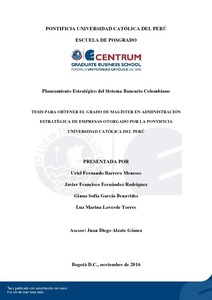| dc.contributor.advisor | Álzate Gómez, Juan Diego | |
| dc.contributor.author | Barrero Meneses, Uriel Fernando | es_ES |
| dc.contributor.author | Fernández Rodríguez, Javier Francisco | es_ES |
| dc.contributor.author | García Benavides, Ginna Sofía | es_ES |
| dc.contributor.author | Laverde Torres, Luz Marina | es_ES |
| dc.date.accessioned | 2017-01-31T17:36:35Z | |
| dc.date.available | 2017-01-31T17:36:35Z | |
| dc.date.created | 2016 | |
| dc.date.issued | 2016-11 | |
| dc.identifier.uri | http://hdl.handle.net/20.500.12404/7590 | |
| dc.description.abstract | Esta tesis presenta el planeamiento estratégico del sistema bancario colombiano para el 2026. El objetivo es diseñar una hoja de ruta que permita al sistema bancario alcanzar su visión de ser referente en Latinoamérica en términos de penetración, alcance, crecimiento y rentabilidad. A partir de esta visión y usando el modelo secuencial de planeamiento estratégico, se recabó información de diferentes fuentes a nivel local y global que permitieran caracterizar el entorno y el interior de la banca en Colombia. Gracias a estos datos, se realizó en primer lugar el análisis externo que permite identificar las posibles oportunidades y amenazas con base en la posición relativa del sistema y de la nación frente a benchmarks y países de la región y se identificó la bancarización, la tasa de interés, el crecimiento bancario, el índice de solvencia, la seguridad y la tecnología financiera como factores claves de éxito del sistema. Este análisis se complementa con el análisis interno para identificar fortalezas y debilidades en aspectos como el administrativo, mercadeo, operacional, financiero, humano, tecnológico y de información. Los insumos mencionados constituyen la base para la generación de estrategias a partir de los factores clave de éxito internos y externos, dentro de las cuales están el desarrollo de productos, el desarrollo de mercados, la penetración de mercados y la diversificación concéntrica. Además de las estrategias, se presentan los objetivos de largo que incluyen el incremento en las cifras de ingresos, utilidades, ROE, empresas bancarizadas y entidades certificadas ambientalmente, así como objetivos de corto plazo que servirán como checkpoints de monitoreo a la hora de implementar las actividades estratégicas que guíen a la banca colombiana a nuevos niveles de bancarización, rentabilidad, eficiencia administrativa y sostenibilidad medioambiental en un plazo de 10 años | es_ES |
| dc.description.abstract | This thesis describes the strategic planning of the banking sector in Colombia for the year 2026. The objective is to draw a roadmap for the achievement of its vision, in order to turn the Colombian banking sector into a regional referent in terms of market penetration, range, growth and profitability. Based on its vision and using the sequential model of strategic planning, it was necessary to gather information from different global and local sources in order to characterize the business environment and the inner sphere of Colombian banking. Thanks to these data, a first external analysis was performed to identify potential opportunities and threats, based on the relative position of the system and the nation versus benchmarks and other countries in the region. As a result, access to banking services, interest rates, banking growth, solvency index, safety and financial technology were defined as the key success factors of the banking sector. This analysis is complemented by the internal analysis performed to identify strengths and weaknesses in areas such as administration, marketing, operations, Finance, human resources, information technology and I+D. All those inputs constitute the basis for the formation of strategies such product development, market development, market penetration and concentric diversification; taking as a starting point the internal and external key success factors. In addition to those strategies, there are long and short objectives that will serve as monitoring checkpoints in the implementation of the strategic activities to drive the Colombian banking system to new levels of accessibility, profitability, administrative efficiency and environmental sustainability in the next ten years | es_ES |
| dc.language.iso | spa | es_ES |
| dc.publisher | Pontificia Universidad Católica del Perú | es_ES |
| dc.rights | Atribución-NoComercial-SinDerivadas 2.5 Perú | * |
| dc.rights | info:eu-repo/semantics/openAccess | es_ES |
| dc.rights.uri | http://creativecommons.org/licenses/by-nc-nd/2.5/pe/ | * |
| dc.subject | Instituciones financieras | es_ES |
| dc.subject | Planificación estratégica | es_ES |
| dc.title | Planeamiento estratégico del sistema bancario colombiano | es_ES |
| dc.type | info:eu-repo/semantics/masterThesis | es_ES |
| thesis.degree.name | Magister en Administración Estratégica de Empresas | es_ES |
| thesis.degree.level | Maestría | es_ES |
| thesis.degree.grantor | Pontificia Universidad Católica del Perú. CENTRUM | es_ES |
| thesis.degree.discipline | Administración Estratégica de Empresas | es_ES |
| renati.discipline | 413307 | es_ES |
| renati.level | https://purl.org/pe-repo/renati/level#maestro | es_ES |
| renati.type | https://purl.org/pe-repo/renati/type#tesis | es_ES |
| dc.publisher.country | PE | es_ES |
| dc.subject.ocde | https://purl.org/pe-repo/ocde/ford#5.02.04 | es_ES |






